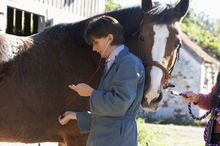A new case of strangles in Volusia County was reported on September 23, 2015. One out of five horses on the premise is affected. The affected horse was imported from a kill facility in Louisiana two days prior to the investigation. The shipper did not notice the clinical signs but the health certificate clearly shows submandibular swelling. This is the second case for Volusia County and the 22nd case of strangles in a horse in Florida in 2015.

Veterinarian checking a horse for strangles symptoms
Separating or quarantining a horse at the earliest signs of strangles is important because the disease is highly contagious and may be passed from one horse to another via nasal secretions and pus from ruptured abscesses in the lymph nodes.
The name "strangles" was coined due to the strangled breathing sounds made by horses with enlarged lymph glands that are characteristic of the disease.
The disease is caused by Streptococcus equi and a horse that is exposed will begin to show symptoms within two to six days. The characteristic abscessed lymph nodes will develop within one to two weeks after exposure. The lymph nodes rupture and drain and the drainage is highly contagious.
Symptoms
- Lack of appetite
- Fever
- Listlessness
- Swelling of lymph nodes in throat area
- Nasal discharge that turns thick and yellow
- Difficulty breathing
Separating or quarantining a horse at the earliest signs of the disease is important because the disease is highly contagious and may be passed from one horse to another via nasal secretions and pus from ruptured abscesses in the lymph nodes. Horses remain contagious for approximately a month after having the disease.
Good horse management techniques are necessary to prevent the spread of the disease through contaminated water buckets, brushes, stalls, fences, or any other surface in the stable or pasture area. Bleach or other disinfectant should be used to wash down stalls including walls and floors, all equipment and tack, and any other surfaces that may have become contaminated by a horse with the disease. Fortunately, the bacteria die fairly quickly in the environment.
